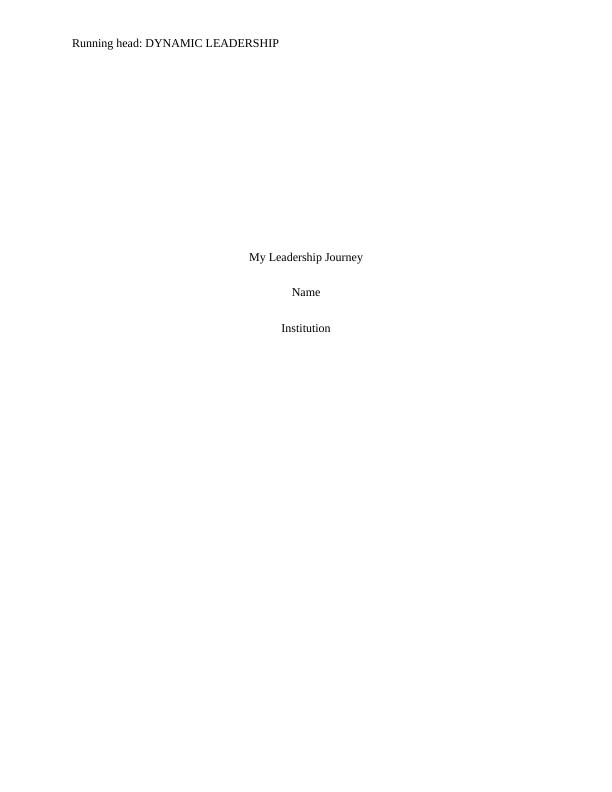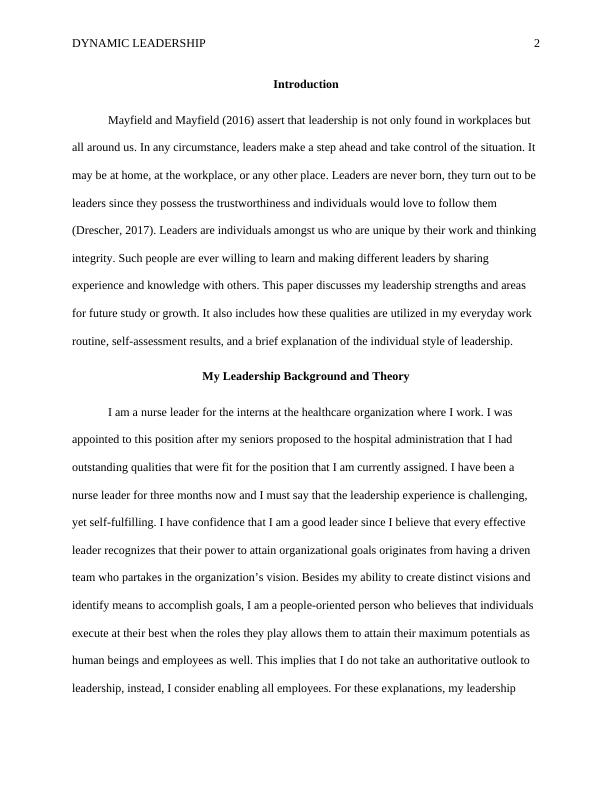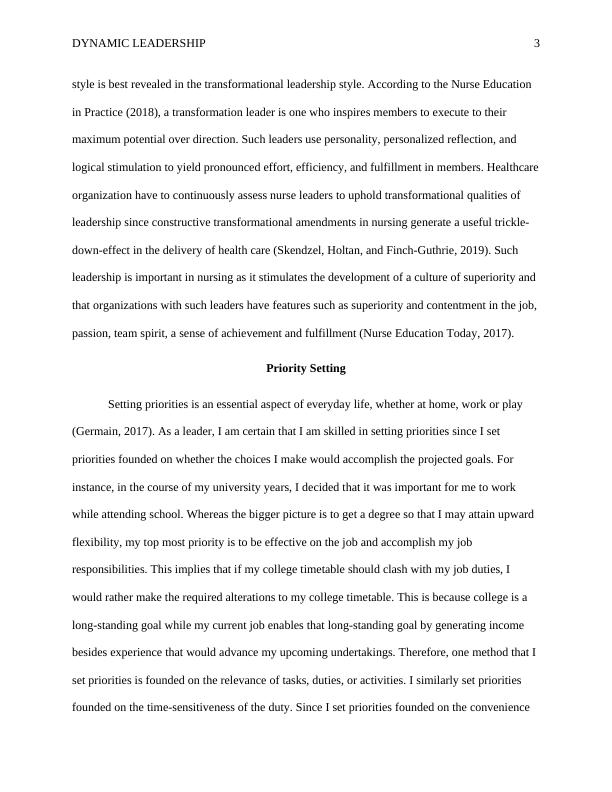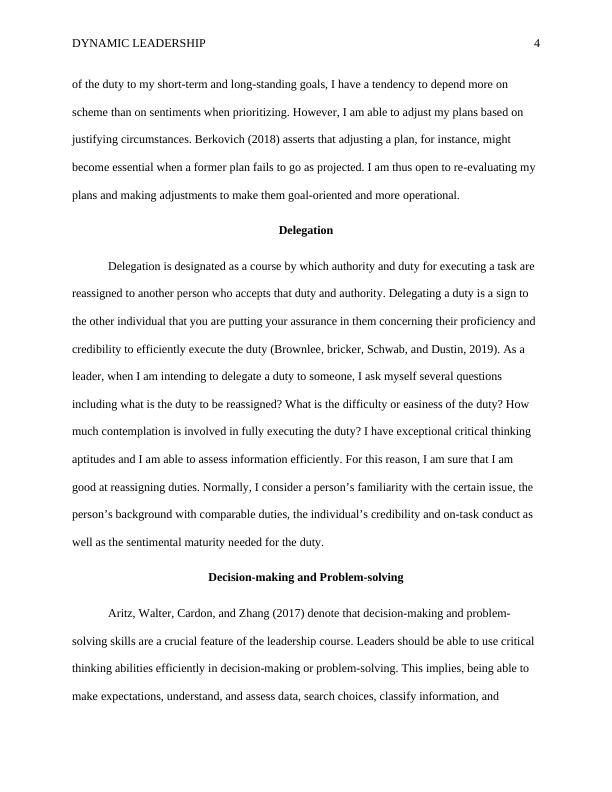Dynamic Leadership
Added on 2023-04-21
11 Pages2755 Words184 Views
Running head: DYNAMIC LEADERSHIP
My Leadership Journey
Name
Institution
My Leadership Journey
Name
Institution

DYNAMIC LEADERSHIP 2
Introduction
Mayfield and Mayfield (2016) assert that leadership is not only found in workplaces but
all around us. In any circumstance, leaders make a step ahead and take control of the situation. It
may be at home, at the workplace, or any other place. Leaders are never born, they turn out to be
leaders since they possess the trustworthiness and individuals would love to follow them
(Drescher, 2017). Leaders are individuals amongst us who are unique by their work and thinking
integrity. Such people are ever willing to learn and making different leaders by sharing
experience and knowledge with others. This paper discusses my leadership strengths and areas
for future study or growth. It also includes how these qualities are utilized in my everyday work
routine, self-assessment results, and a brief explanation of the individual style of leadership.
My Leadership Background and Theory
I am a nurse leader for the interns at the healthcare organization where I work. I was
appointed to this position after my seniors proposed to the hospital administration that I had
outstanding qualities that were fit for the position that I am currently assigned. I have been a
nurse leader for three months now and I must say that the leadership experience is challenging,
yet self-fulfilling. I have confidence that I am a good leader since I believe that every effective
leader recognizes that their power to attain organizational goals originates from having a driven
team who partakes in the organization’s vision. Besides my ability to create distinct visions and
identify means to accomplish goals, I am a people-oriented person who believes that individuals
execute at their best when the roles they play allows them to attain their maximum potentials as
human beings and employees as well. This implies that I do not take an authoritative outlook to
leadership, instead, I consider enabling all employees. For these explanations, my leadership
Introduction
Mayfield and Mayfield (2016) assert that leadership is not only found in workplaces but
all around us. In any circumstance, leaders make a step ahead and take control of the situation. It
may be at home, at the workplace, or any other place. Leaders are never born, they turn out to be
leaders since they possess the trustworthiness and individuals would love to follow them
(Drescher, 2017). Leaders are individuals amongst us who are unique by their work and thinking
integrity. Such people are ever willing to learn and making different leaders by sharing
experience and knowledge with others. This paper discusses my leadership strengths and areas
for future study or growth. It also includes how these qualities are utilized in my everyday work
routine, self-assessment results, and a brief explanation of the individual style of leadership.
My Leadership Background and Theory
I am a nurse leader for the interns at the healthcare organization where I work. I was
appointed to this position after my seniors proposed to the hospital administration that I had
outstanding qualities that were fit for the position that I am currently assigned. I have been a
nurse leader for three months now and I must say that the leadership experience is challenging,
yet self-fulfilling. I have confidence that I am a good leader since I believe that every effective
leader recognizes that their power to attain organizational goals originates from having a driven
team who partakes in the organization’s vision. Besides my ability to create distinct visions and
identify means to accomplish goals, I am a people-oriented person who believes that individuals
execute at their best when the roles they play allows them to attain their maximum potentials as
human beings and employees as well. This implies that I do not take an authoritative outlook to
leadership, instead, I consider enabling all employees. For these explanations, my leadership

DYNAMIC LEADERSHIP 3
style is best revealed in the transformational leadership style. According to the Nurse Education
in Practice (2018), a transformation leader is one who inspires members to execute to their
maximum potential over direction. Such leaders use personality, personalized reflection, and
logical stimulation to yield pronounced effort, efficiency, and fulfillment in members. Healthcare
organization have to continuously assess nurse leaders to uphold transformational qualities of
leadership since constructive transformational amendments in nursing generate a useful trickle-
down-effect in the delivery of health care (Skendzel, Holtan, and Finch-Guthrie, 2019). Such
leadership is important in nursing as it stimulates the development of a culture of superiority and
that organizations with such leaders have features such as superiority and contentment in the job,
passion, team spirit, a sense of achievement and fulfillment (Nurse Education Today, 2017).
Priority Setting
Setting priorities is an essential aspect of everyday life, whether at home, work or play
(Germain, 2017). As a leader, I am certain that I am skilled in setting priorities since I set
priorities founded on whether the choices I make would accomplish the projected goals. For
instance, in the course of my university years, I decided that it was important for me to work
while attending school. Whereas the bigger picture is to get a degree so that I may attain upward
flexibility, my top most priority is to be effective on the job and accomplish my job
responsibilities. This implies that if my college timetable should clash with my job duties, I
would rather make the required alterations to my college timetable. This is because college is a
long-standing goal while my current job enables that long-standing goal by generating income
besides experience that would advance my upcoming undertakings. Therefore, one method that I
set priorities is founded on the relevance of tasks, duties, or activities. I similarly set priorities
founded on the time-sensitiveness of the duty. Since I set priorities founded on the convenience
style is best revealed in the transformational leadership style. According to the Nurse Education
in Practice (2018), a transformation leader is one who inspires members to execute to their
maximum potential over direction. Such leaders use personality, personalized reflection, and
logical stimulation to yield pronounced effort, efficiency, and fulfillment in members. Healthcare
organization have to continuously assess nurse leaders to uphold transformational qualities of
leadership since constructive transformational amendments in nursing generate a useful trickle-
down-effect in the delivery of health care (Skendzel, Holtan, and Finch-Guthrie, 2019). Such
leadership is important in nursing as it stimulates the development of a culture of superiority and
that organizations with such leaders have features such as superiority and contentment in the job,
passion, team spirit, a sense of achievement and fulfillment (Nurse Education Today, 2017).
Priority Setting
Setting priorities is an essential aspect of everyday life, whether at home, work or play
(Germain, 2017). As a leader, I am certain that I am skilled in setting priorities since I set
priorities founded on whether the choices I make would accomplish the projected goals. For
instance, in the course of my university years, I decided that it was important for me to work
while attending school. Whereas the bigger picture is to get a degree so that I may attain upward
flexibility, my top most priority is to be effective on the job and accomplish my job
responsibilities. This implies that if my college timetable should clash with my job duties, I
would rather make the required alterations to my college timetable. This is because college is a
long-standing goal while my current job enables that long-standing goal by generating income
besides experience that would advance my upcoming undertakings. Therefore, one method that I
set priorities is founded on the relevance of tasks, duties, or activities. I similarly set priorities
founded on the time-sensitiveness of the duty. Since I set priorities founded on the convenience

DYNAMIC LEADERSHIP 4
of the duty to my short-term and long-standing goals, I have a tendency to depend more on
scheme than on sentiments when prioritizing. However, I am able to adjust my plans based on
justifying circumstances. Berkovich (2018) asserts that adjusting a plan, for instance, might
become essential when a former plan fails to go as projected. I am thus open to re-evaluating my
plans and making adjustments to make them goal-oriented and more operational.
Delegation
Delegation is designated as a course by which authority and duty for executing a task are
reassigned to another person who accepts that duty and authority. Delegating a duty is a sign to
the other individual that you are putting your assurance in them concerning their proficiency and
credibility to efficiently execute the duty (Brownlee, bricker, Schwab, and Dustin, 2019). As a
leader, when I am intending to delegate a duty to someone, I ask myself several questions
including what is the duty to be reassigned? What is the difficulty or easiness of the duty? How
much contemplation is involved in fully executing the duty? I have exceptional critical thinking
aptitudes and I am able to assess information efficiently. For this reason, I am sure that I am
good at reassigning duties. Normally, I consider a person’s familiarity with the certain issue, the
person’s background with comparable duties, the individual’s credibility and on-task conduct as
well as the sentimental maturity needed for the duty.
Decision-making and Problem-solving
Aritz, Walter, Cardon, and Zhang (2017) denote that decision-making and problem-
solving skills are a crucial feature of the leadership course. Leaders should be able to use critical
thinking abilities efficiently in decision-making or problem-solving. This implies, being able to
make expectations, understand, and assess data, search choices, classify information, and
of the duty to my short-term and long-standing goals, I have a tendency to depend more on
scheme than on sentiments when prioritizing. However, I am able to adjust my plans based on
justifying circumstances. Berkovich (2018) asserts that adjusting a plan, for instance, might
become essential when a former plan fails to go as projected. I am thus open to re-evaluating my
plans and making adjustments to make them goal-oriented and more operational.
Delegation
Delegation is designated as a course by which authority and duty for executing a task are
reassigned to another person who accepts that duty and authority. Delegating a duty is a sign to
the other individual that you are putting your assurance in them concerning their proficiency and
credibility to efficiently execute the duty (Brownlee, bricker, Schwab, and Dustin, 2019). As a
leader, when I am intending to delegate a duty to someone, I ask myself several questions
including what is the duty to be reassigned? What is the difficulty or easiness of the duty? How
much contemplation is involved in fully executing the duty? I have exceptional critical thinking
aptitudes and I am able to assess information efficiently. For this reason, I am sure that I am
good at reassigning duties. Normally, I consider a person’s familiarity with the certain issue, the
person’s background with comparable duties, the individual’s credibility and on-task conduct as
well as the sentimental maturity needed for the duty.
Decision-making and Problem-solving
Aritz, Walter, Cardon, and Zhang (2017) denote that decision-making and problem-
solving skills are a crucial feature of the leadership course. Leaders should be able to use critical
thinking abilities efficiently in decision-making or problem-solving. This implies, being able to
make expectations, understand, and assess data, search choices, classify information, and

End of preview
Want to access all the pages? Upload your documents or become a member.
Related Documents
Assignment on Transcript Leadership In Clinical Nursinglg...
|5
|1145
|5
Effective Nursing Leadership Styles for Quality Patient Outcomelg...
|7
|1536
|129
Transformational Leadership in Nursing Practicelg...
|5
|1071
|408
Essay about Nursing Leadershiplg...
|11
|4301
|89
Leadership Styles and Their Impact on Quality and Care Initiatives in Saudi Healthcarelg...
|10
|1092
|339
MRE5003: Industrial techniques in maintenance managementlg...
|5
|1135
|42